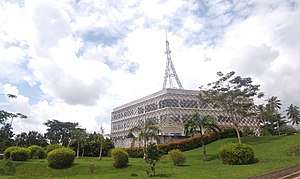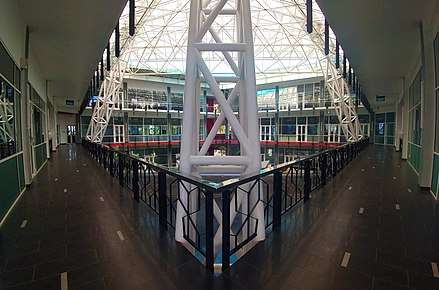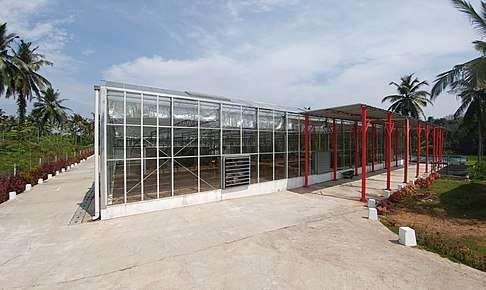Sri Lanka Institute of Nanotechnology
  The Nanotechnology Center for Excellence, opened in 2013. Currently houses SLINTEC | |
| Established | 2008 |
|---|---|
| Focus | Nanotechnology and allied research |
| Chairman | Deshamanya Mahesh Amalean |
| CEO | Harin De Silva Wijeyeratne |
| Staff | 100+ |
| Key people |
Gehan Amaratunga (Chief of Research and Innovation) Ananda Hettiarachchi (Chief of Process & Engineering Systems) Nalin De Silva (Science Team Leader) |
| Budget | LKR 250 million (Treasury allocation; 2017)[1] |
| Subsidiaries |
SLINTEC Academy SLINTEC Analytical Services |
| Owner |
Public–private partnership between:
|
| Location | Nanotechnology & Science Park, Mahenwatta, Pitipana, Homagama 10206, Sri Lanka |
| Coordinates | 6°49′34″N 80°02′17″E / 6.826241°N 80.038178°ECoordinates: 6°49′34″N 80°02′17″E / 6.826241°N 80.038178°E |
| Website | slintec.lk |
The Sri Lanka Institute of Nanotechnology (Sinhalese: ශ්රී ලංකා නිනිති තාක්ෂණ ආයතනය; Tamil: இலங்கை நனோ தொழில்நுட்ப நிறுவனம்) (abbreviated and commonly known as SLINTEC) is a Sri Lankan research institute specializing in the field of nanotechnology. It was incorporated in 2008 as a public-private partnership between the Government of Sri Lanka and five private companies, and is notable for being the first public-private research institute in the country.[2][3]
In 2017, it was accredited as a degree-awarding institution by the Ministry of Higher Education and Highways, leading to the establishment of the SLINTEC Academy.[4][5][6]
Background
The idea of a national science policy for Sri Lanka was first discussed in the 1980s, although the matter did not move forward in any concrete way for several decades due to the more pressing economic and budgetary needs of the civil war on successive administrations.[7] Nevertheless, a presidential taskforce was appointed in 1991 to examine possible policy actions to be taken in the field of the sciences.[7] Further advancements came some years later, when the Science and Technology Act No. 11 of 1994 established, among others, the National Science Foundation (NSF; formally founded in 1998 for funding scientific research in the country) and the National Science and Technology Commission (NASTEC; formally founded in August 1998 to formulate scientific policy) under the newly-established Ministry of Science and Technology (MoST).[7][8][9][10] Despite these efforts, R&D investments in the country were minimal, being just 0.19% GDP in 2006 (0.11% in 2008), lower than regional peers such as India (0.61%) and Malaysia (0.63%), and generally holding at <0.2% through the years.[7][11][12] This has been attributed to various factors, including a lack of an innovation culture in Sri Lanka and a risk-averse private sector that did not see much benefit in local R&D ventures.[12] Sri Lanka has thus underperformed significantly in increasing the share of high technology exports as a percentage of its total manufactured exports when compared to regional peers such as India.[13]
History
The National Nanotechnology Initiative was formed informally in the early 2000s as a collaborative effort between a group of expatriate Sri Lankan scientists and officials from the NSF and the MoST, seeking to promote nanotechnology research in Sri Lanka.[14] The Initiative cited several other related objectives:[14]
- developing nanotechnology-based industry in Sri Lanka
- attracting nanotechnology expertise of Sri Lankans both in the country and outside it
- increasing the competitiveness of local industry through local R&D
- value addition to national resources slated for exports
- developing a local skills base centered around nanotechnology.
The Initiative approached the minister of science and technology at the time, Tissa Vitharana, going on to brief the president in a presentation in November 2005.[14][15] This resulted in a cabinet memorandum the same year, proposing the formal commitment of the Government of Sri Lanka to the initiative, which was approved by the cabinet on 23 August 2006.[3][14] It defined a broad objective of generating a pool of experts with all necessary facilities for nanotechnology-based research at a national level.[14] Due to a lack of funds, however, the project stagnated until the efforts of Ravi Silva, a Sri Lankan professor and nanotechnology specialist at the University of Surrey, who persuaded five private companies to consider investing in the venture.[3][16]
The Ministry of Science and Technology announced a public-private partnership to establish a nanotechnology venture in 2007 with a holding company, NANCO (Pvt.) Ltd., being founded soon after. SLINTEC (through NANCO) was established with the state owning a 50% stake via an initial investment of LKR 250 million through the National Science Foundation, and five private sector partners each investing LKR 40 million and owning 10% stakes for a total seed capital of LKR 450 million.[15][17]

SLINTEC was incorporated as a private company in April 2008.[18] In September of that year, the Board of Investment signed an agreement with NANCO for the development and management of a nanotechnology park in Homagama.[17][19] SLINTEC was launched officially on 1 December 2008, with initial work taking place in a garage; formal research work commenced on 12 August 2009, operating out of MAS Holdings' Silueta complex within the Biyagama Export Processing Zone, with research staff drawn from local universities.[3][15][20] In 2010, NANCO was merged into SLINTEC.[21] The construction of phase 1a of the Nanotechnology Center for Excellence on a 50 acre land within the Homagama Nanotechnology and Science Park began in June 2012, with the hexagonal facility formally opening on 23 October 2013.[18][22] It currently houses both SLINTEC and the SLINTEC Academy, and a second hexagon is slated for completion by 2019.[3]
In 2013, Lankem joined SLINTEC as its sixth private sector partner.[22]

In 2016, the Yunnan Rural Science and Technology Service Center helped establish a greenhouse within the Nanotechnology Park for use by SLINTEC.[23][24]
Private sector collaboration
In March 2012, SLINTEC signed two commercial agreements:
- One with Nagarjuna Fertilizers and Chemicals Ltd. (NFCL), India. Funded by the agrochemicals arm of its private sector partner Hayleys, SLINTEC had undertaken research into a nanoparticle-based slow-release fertilizer that reduced fertilizer loss through leaching, microbial degradation and other methods (accounting for between 50-70% of conventional fertilizer wastage).[21][22][25][26] NFCL bought the patent for the slow-release fertilizer for USD 2.2 million, acquiring rights for commercial production and distribution outside Sri Lanka.[21][25][26][27] As part of the agreement, NFCL invested a further USD 0.8 million as a seed fund for SLINTEC to develop second- and third-generation nanotechnology-based fertilizer products for NFCL.[21][25][26][27]
- Another with LAUGFS Holdings, wherein the two companies would establish a pilot plant to produce titanium dioxide from the country's large ilmenite mineral sands reserves, ranked 9th in the world at close to 18 million metric tonnes.[3][21][28][29] The venture was based on SLINTEC research initially funded by the Ministry of Technology and Research and the National Science Foundation, drawing a LKR 80 million investment from LAUGFS.[29][30]
Other private sector clients of SLINTEC include MAS Holdings, Teejay Lanka PLC (formerly Textured Jersey), CIC Holdings, British Cosmetics and Dynawash.[3][31][32][33][34][35]
Research focus areas
- Agriculture[36]
- Nanofertilizers
- Insecticides and pesticides
- Targeted nutrient systems
- Apparel/textiles[36]
- Healthcare[3][36]
- Mineral processing[36]
- Synthesising graphene
- Extraction of titanium dioxide from ilmenite/production of titanium
SLINTEC Academy
| Motto | Latin: Educare et Educere |
|---|---|
| Type | Graduate school |
| Established | 2017 |
Parent institution | Sri Lanka Institute of Nanotechnology |
| Chancellor | Deshamanya Mahesh Amalean |
| Vice-Chancellor | Veranja Karunaratne |
| Provost | Ranil Gunaratne |
Academic staff | 30[3] |
| Postgraduates | 19 |
| 6 | |
| Address |
Nanotechnology & Science Park, Mahenwatta, Pitipana, Homagama 10206, Sri Lanka 6°49′34″N 80°02′17″E / 6.826241°N 80.038178°E |
| Campus | Urban |
| Language | English |
| Colors | |
| Website |
slintecacademy |
 | |
The Academy of the Sri Lanka Institute of Nanotechnology (also known as SLINTEC Academy) is a private non-profit graduate school, founded as SLINTEC's knowledge dissemination arm.[37] The school offers MPhil and PhD degrees in Nano- and Advanced Sciences, and was formally inaugurated on 22 September 2017 at the Lakshman Kadirgamar Institute.[5][6][37] The Academy focuses on industry-oriented research as a core component of its course-/degree work, with a view towards creating a skills base within the country.[3][37]
Establishment
Extraordinary gazette 2032/23 of the Government of Sri Lanka recognized SLINTEC as a degree-awarding higher education institute on 16 August 2017.[38] SLINTEC then established the Academy as a separate entity for the execution of the institute's educational mandate, with industrialist and entrepreneur Mahesh Amalean appointed Chancellor.[5][6] The school's first intake consisted of 19 students: 6 PhD- and 13 MPhil researchers.
See also
References
- ↑ Ministry of Finance, Sri Lanka (10 November 2016). "Budget Speech 2017". Treasury.gov.lk. Ministry of Finance, Sri Lanka. p. 101. Retrieved 3 September 2017.
- ↑ "SLINTEC launches certificate course in nanotechnology". ft.lk. Daily Financial Times. 7 December 2015. Retrieved 18 January 2018.
- 1 2 3 4 5 6 7 8 9 10 Hettiarachchi, Kumudini (14 January 2018). "Stepping into our own 'magical' world of nano". sundaytimes.lk. The Sunday Times. Retrieved 18 January 2018.
- ↑ "Nano degrees from SL's Nano Institute". Sundaytimes.lk. The Sunday Times Sri Lanka. 20 August 2017. Retrieved 4 September 2017.
- 1 2 3 "Slintec Academy to Emerge as the Leading Post Graduate degree provider in Advanced Technologies Slintec Academy to Emerge as the Leading Post Graduate degree provider in Advanced Technologies". Island.lk. The Island. 4 March 2017. Retrieved 3 September 2017.
- 1 2 3 "SLINTEC Academy: Boon to Sri Lankan post graduate degree seekers in cutting edge technology". Ft.lk. Financial Times of Sri Lanla. 6 March 2017. Retrieved 3 September 2017.
- 1 2 3 4 Gamage, Tharaka (16 September 2010). "Sri Lanka's science plan moves ahead at last". scidev.net. SciDevNet. Retrieved 4 September 2017.
- ↑ "Science and Technology Development Act". SriLankaLaw lk. Blackball Publishing. Retrieved 4 September 2017.
- ↑ "History". NSF.ac.lk. National Science Foundation of Sri Lanka. Retrieved 4 September 2017.
- ↑ "About Us". NASTEC.lk. National Science and Technology Commission of Sri Lanka. Retrieved 4 September 2017.
- ↑ Mashelkar, R.A. (June 2009). Leveraging High Technology to Drive Innovation & Competitiveness & Build the Sri Lankan Knowledge Economy. The World Bank. Retrieved 4 September 2017.
- 1 2 Daniel, Smriti (14 March 2013). "Sri Lanka launches office to foster innovation". Scidev.net. SciDevNet. Retrieved 4 September 2017.
- ↑ Acharyya, Rajat (2005). "2.2". Product Standards, Exports and Employment: An Analytical Study. Heidelberg, Germany: Physica-Verlag. p. 6. ISBN 3-7908-1557-8. Retrieved 5 September 2017.
- 1 2 3 4 5 De Alwis, Ajith (1 July 2012). "Nanotechnology in Sri Lanka:A new beginning with a new technology but commitment is key". Island.lk. The Island. Retrieved 4 September 2017.
- 1 2 3 "Nanotechnology products in three years". Sundaytimes.lk. The Sunday Times Sri Lanka. 8 February 2009. Retrieved 4 September 2017.
- ↑ "Professor Ravi Silva". University of Surrey. surrey.ac.uk. Retrieved 18 January 2018.
- 1 2 "Sri Lanka to set up nanotechnology research institute". Nanowerk. 22 December 2007. Retrieved 4 September 2017.
- 1 2 "Sri Lanka's first nanotechnology research center and nanoscience park opens". Colombopage.com. Colombo Page. 21 October 2013. Retrieved 4 September 2017.
- ↑ "World's first Nanotechnology Park in Sri Lanka". Sundaytimes.lk. The Sunday Times of Sri Lanka. 24 September 2008. Retrieved 4 September 2017.
- ↑ De Alwis, Ajith (1 December 2011). "Bringing the world to Sri Lanka". FT.lk. Daily Financial Times Sri Lanka. Retrieved 4 September 2017.
- 1 2 3 4 5 Tomczyk, Michael (2015). NanoInnovation: What Every Manager Needs to Know. Weinheim, Germany: Wiley-VCH. p. 205. ISBN 978-3-527-32672-3. Retrieved 4 September 2017.
- 1 2 3 De Silva Wijeyeratne, Harin (19 October 2013). "President Opend [sic] the newly built Nanotechnology Centre of Excellence". Island.lk. The Island. Retrieved 4 September 2017.
- ↑ "SLINTEC: Steering Sri Lanka's Quantum Leap Into the Future". ForbesCustom. custom.forbes.com. 12 December 2016. Retrieved 27 September 2017.
- ↑ Wijewardena, W.A. (21 August 2017). "Sri Lanka's march toward emerging sciences: A rugged road but not impossible to tread". My View: Economic Matters. FT.lk. Daily Financial Times. Retrieved 27 September 2017.
- 1 2 3 Karunaratne, Veranja; Amaratunge, Gehan (17 March 2012). "Sri Lanka Institute of Nanotechnology (SLINTEC) reaches a significant scientific milestone". Island.lk. The Island. Retrieved 4 September 2017.
- 1 2 3 "SLINTEC enters strategic technology development agreement with NFCL, India". FT.lk. Daily Financial Times. 19 March 2012. Retrieved 4 September 2017.
- 1 2 "Indian fertilizer giant buys SLINTEC research for $ 3 mn". Island.lk. The Island. 17 March 2012. Retrieved 4 September 2017.
- ↑ "Tech Use". Lankabusinessonline.com. Lanka Business Online. 13 March 2013. Retrieved 4 September 2017.
- 1 2 "LAUGFS, SLINTEC strike deal to set up titanium dioxide plant". Sundaytimes.lk. The Sunday Times of Sri Lanka. 11 March 2012. Retrieved 4 September 2017.
- ↑ "Material Magic". Echelon magazine. Echelon. 17 March 2014. Retrieved 4 September 2017.
- ↑ "MAS Holdings obtains high tech patent from SLINTEC". Dailynews.lk. Daily News Sri Lanka. 8 December 2016. Retrieved 4 September 2017.
- ↑ "MAS acquires first patent from local high-tech research institute". Dailymirror.lk. Daily Mirror Sri Lanka. 29 November 2016. Retrieved 4 September 2017.
- ↑ "SLINTEC signs agreement with British Cosmetics to engage in cosmetics research". ft.lk. Financial Times. 7 February 2017. Retrieved 18 January 2018.
- ↑ "SLINTEC-Dynawash collaboration continues". ft.lk. Daily Financial Times. 29 November 2017. Retrieved 18 January 2018.
- ↑ "CIC signs deal with SLINTEC for pioneering research project". dailymirror.lk. Daily Mirror. 25 September 2015. Retrieved 19 January 2018.
- 1 2 3 4 "Research Focus Areas". slintec.lk. Sri Lanka Institute of Nanotechnology. Retrieved 27 September 2017.
- 1 2 3 Karunaratne, Veranja. "SLINTEC ACADEMY Launches its MPhil degree in Nano and Advanced Technology". LinkedIn. LinkedIn Pulse. Retrieved 23 November 2017.
- ↑ "The Gazette of the Democratic Socialist Republic of Sri Lanka" (PDF). Documents.gov.lk. The Government of Sri Lanka. Retrieved 21 September 2017.